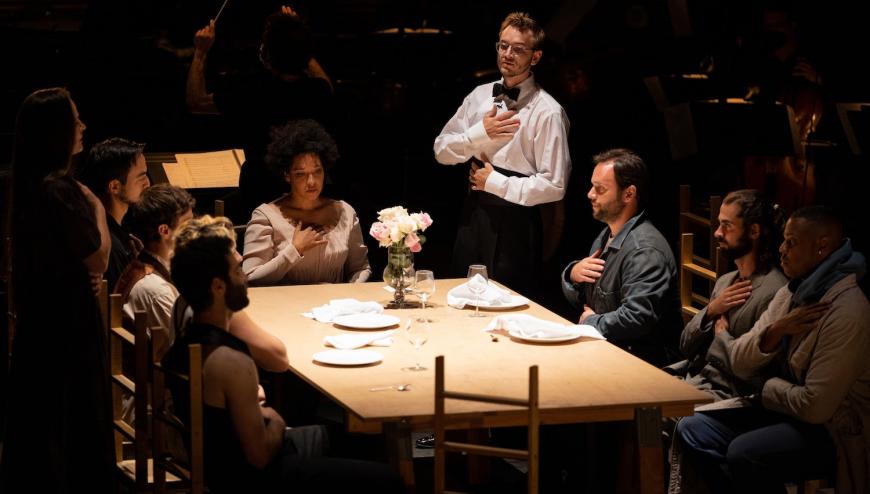
The No One’s Rose is an opera (sort of) by Matthew Aucoin (somewhat). More accurately, it is an operatic, theatrical chamber work co-created by Aucoin and a collective of musicians and dancers. It is not about the COVID-19 pandemic or about climate change or about trauma and survival, but it is art birthed from and into those circumstances, and it speaks to them powerfully and directly.
It makes sense that a work so rooted in our times would be created by a collective, and that it would center specific individual experiences. After all, living through a pandemic has highlighted how closely our individual health is tied to our collective health. And while people around the globe are living through the same catastrophes, our experiences of them have been isolated and strikingly unique.
The No One’s Rose encapsulates those varied experiences viscerally through music, dance, and poetry. Commissioned by the Philharmonia Baroque Orchestra & Chorale and Stanford Live, it was co-produced by that orchestra and the American Modern Opera Company (AMOC), members of which presented three performances last week in Palo Alto at Bing Concert Hall on the campus of Stanford University. The audience was vaccinated (a requirement for entry), masked, and sparse, a reminder in and of itself of the times in which we live and the privileged positions we often occupy within them.
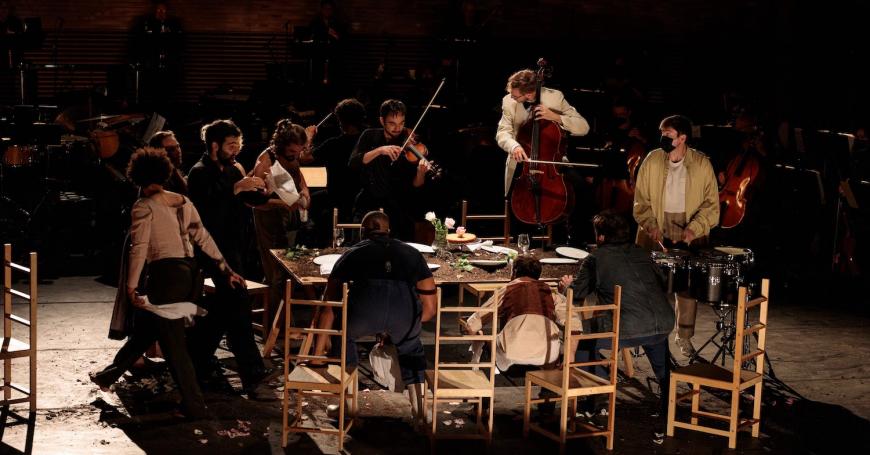
Aucoin composed the score, but even that felt like the result of collaboration. Music by Johann Sebastian Bach, Franz Schubert, Hector Berlioz, Paul Simon, and Sam Cooke is woven into the piece, and at times their voices take center stage. Alternating between the podium and piano bench during the performance, Aucoin quietly played the role of collaborator and master of ceremonies in real time just as he did compositionally.
Director Zack Winokur centered the action onstage around a communal dinner table, a highly effective and flexible prop. (How many of us longed to eat dinner with friends and family around a big happy table during the most isolating months of the pandemic?).
Winokur also here fully enmeshes stage direction with choreography (by dancer Bobbi Jene Smith) in a way that reminded me of Chris Emile’s stunning choreography for Long Beach Opera’s May 2021 production of Philip Glass’s Les Enfants Terribles. Like that production, The No One’s Rose offered seamlessly integrated dance and operatic performances. As in that production, the cast rose to the occasion. At one point, bass-baritone Davóne Tines was twisted up like a pretzel on the ground. Every singer onstage gave active, physical performances. Orchestral musicians, too, moved and danced, all while playing in striking cohesion.
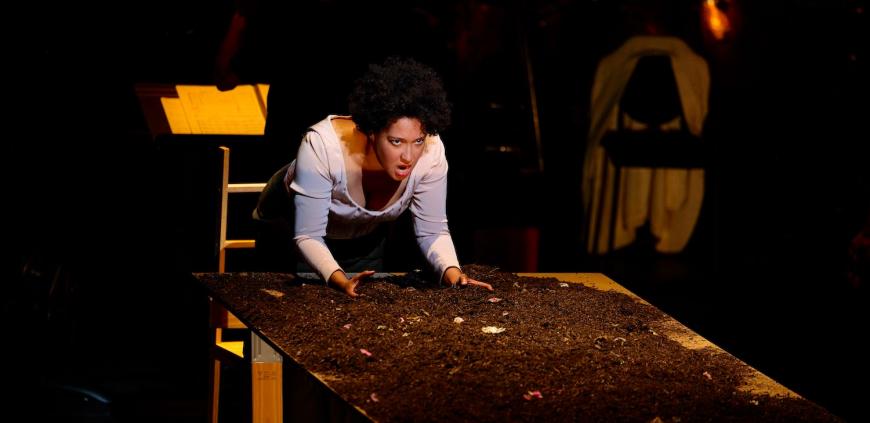
The text of this work comes from a chorus of individuals, featuring lyrics by poets Paul Celan, Johann Mayrhofer, Théophile Gautier, and Jorie Graham presented alongside personal musings of the singers and musicians in the ensemble.
Those singers and musicians, and the stories they shared, provided some of the work’s most dramatic and poignant moments. Violinist Keir GoGwilt contributed text and music, recounting the experience of performing virtually for a COVID patient in an ICU unit. “Under her gaze something bloomed,” he spoke. That something? “I who had been playing for no one.”
Lines like that, accompanied by sparse Baroque melodies, painted vivid pictures. Of the interior of a hospital room where a dying woman lies listening to a plaintive melody. Of a musician who thrives as a performer but is suddenly isolated at home with no audience. And, most importantly, of a moment of humanity exchanged between them.
That same scenario reappeared later in the work when Tines described a similar experience. It’s the sort of thing you might’ve read about in the news, a feel-good story with a headline like, “Opera singer performs for COVID patients.” But Tines here reveals the dichotomy of such a moment, how one can simultaneously feel overwhelming compassion for a dying soul and worry about hitting a high note. How beauty can so often invade a painful, traumatic experience, or at least coexist within it.
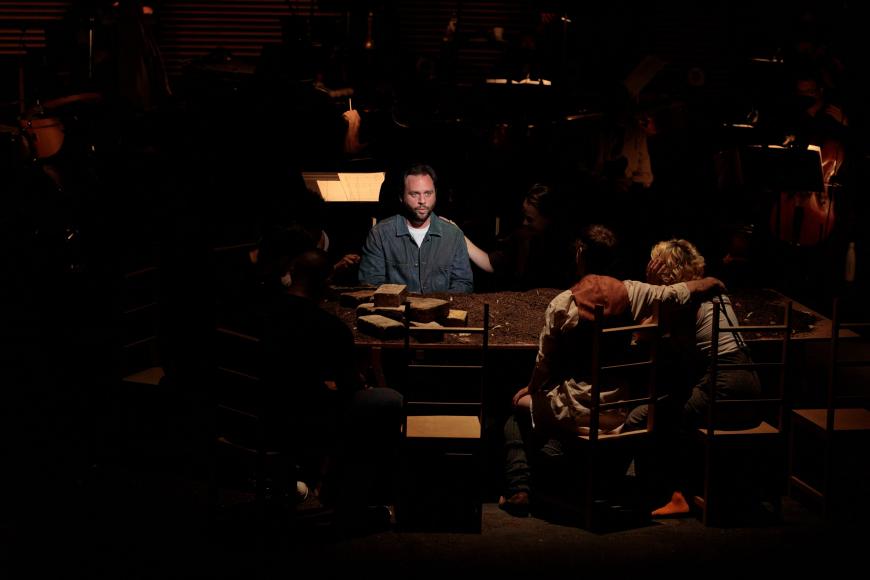
Countertenor Anthony Roth Costanzo broke the somber mood, at one point declaring “In my dreams, I’m hosting a dinner party,” before launching into a florid vocal expression of joy. “If we don’t let this energy out, it’s going to explode,” the libretto read, as dancers and singers and musicians alike erupted in manic frenzy. Percussionist Jonny Allen at one point reveled in unchecked rage, beating his drum in a crescendo that only climaxed when he was physically pulled away from the instrument by fellow performers.
Rather than focusing on her lived experiences, soprano Julia Bullock often sang texts by Holocaust survivor and poet Paul Celan. Celan’s poetry, from which the title of the piece is derived, provided context throughout the piece, a guide for how to survive and process trauma.
It was, in fact, Celan’s poetry and Bach’s music that inspired this work. Even before the pandemic, Aucoin, who studied poetry at Harvard as an undergraduate, was working on a piece called “The No One’s Rose” that would juxtapose Bach’s chorales with Celan’s poetry and his own musical creations. But, as he noted in the program, the direction of the piece was altered by the pandemic. Not only was it postponed, but the materials of it were expanded to include reflections of our own time.
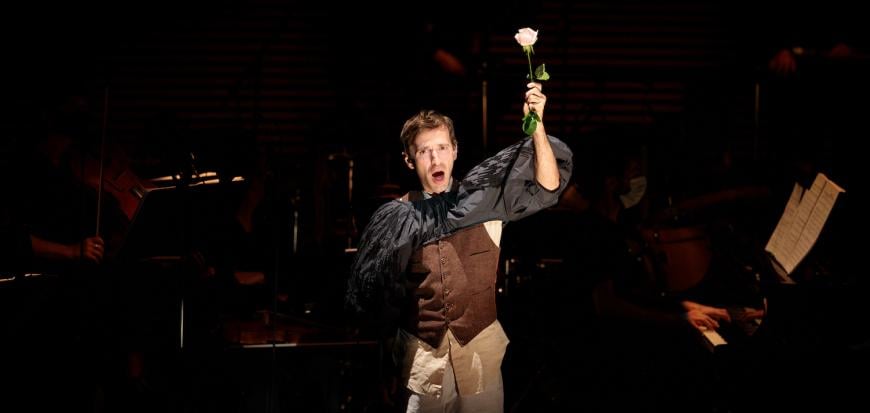
The resulting work could have felt like an overworked recipe, too many cooks in the kitchen and too many ingredients included. Instead, Celan’s and Bach’s voices provided historical context and framed the work, acting as reminder that the traumas of our day have precedent, and that we can look back for guidance as we navigate them.
Tenor Paul Appleby made this point most strikingly when he picked up a guitar and sang Paul Simon’s “American Tune.” Simon’s words channeled through Appleby’s clear, handsome vocals were revelatory. “I don’t know a soul who’s not been battered, I don’t have a friend who feels at ease,” he sang. Fifty years have passed since Simon wrote the words, but they ring true today.
Everyone I know feels battered and uneasy right now. The No One’s Rose digs its heels into that reality.
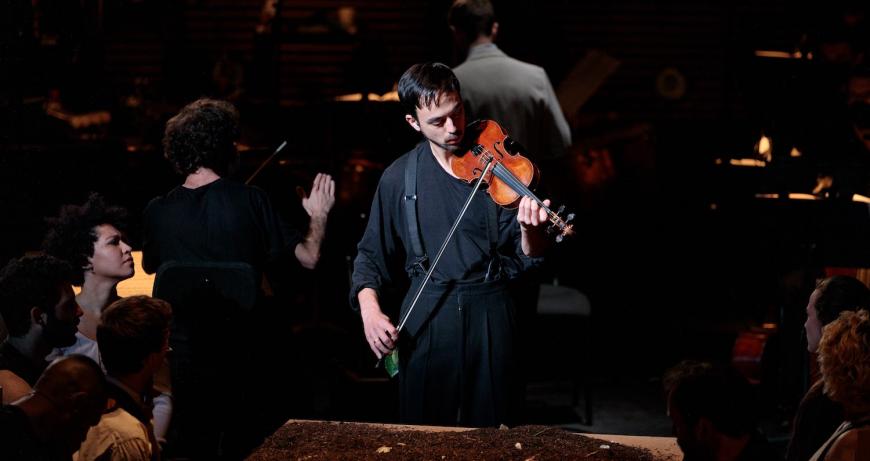
CORRECTION: A caption in a photo above misidentified Paul Appleby as Davón TInes.




